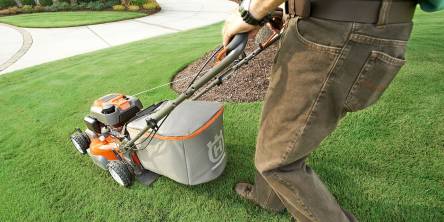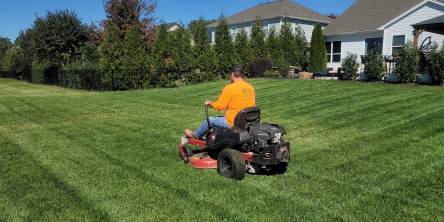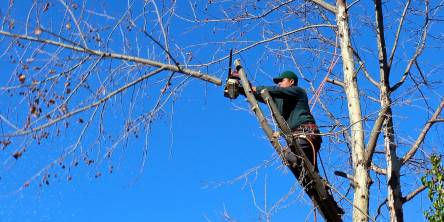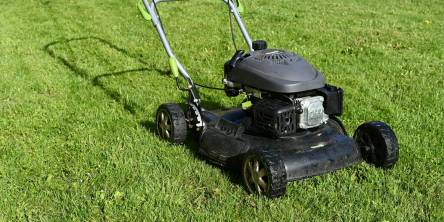Plants and Flowers That You'd See in A Seasoned Survivalist's Yard (or Plants That Do Double Duty)

Most survivalists keep a thriving vegetable garden as well as a myriad of fruit trees. However, many people have gardens. Survivalists go one step further.
You can survive three weeks without food, once these supplies run out. But then what? Take a hint from true survivalists and consider growing these plants that do double duty as both adding charm to your yard and food for your mouth.
Top Nine Plants for Survival
While finding water and shelter are of utmost importance, it is still important to find and prepare food. There are thousands of edible plants, many that grow wild in your own backyard. While it’s a good idea to try to learn each one, it’s also beneficial to purposely grow some of these plants on your property.
Below you will find the ten wild plants that are easiest to find, prepare, and identify in the wild. They also can serve multiple uses in a survival situation. While they aren’t all the best choices in food substitutes, they are all edible and can provide your body with necessary vitamins and minerals.
One: Balsam Root
Every part of the balsamroot plant can be consumed. It has large, arrowhead-shaped leaves and a single flower that resembles a sunflower. The plant’s triangular leaves are so specifically-shaped that the plant also goes by the moniker of “arrowleaf.”
The flavorful root can be eaten any way imaginable, while its young shoots are best boiled or raw. The older leaves tend to be quite fibrous, but are still acceptable to eat once boiled. Roast or ground the seeds into a flour for consumption.
Two: Burdock
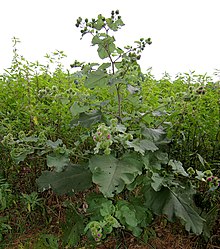 This medium to large-sized plant is recognizable by its purple-colored flower heads. The large leaves and peeled stalks can be eaten raw in a salad or boiled for a softer texture. The leaves, however, are bitter. The best method for consumption is to boil them, change the water, then boil them again to remove the bitter taste. The roots can be washed, boiled, and eaten.
This medium to large-sized plant is recognizable by its purple-colored flower heads. The large leaves and peeled stalks can be eaten raw in a salad or boiled for a softer texture. The leaves, however, are bitter. The best method for consumption is to boil them, change the water, then boil them again to remove the bitter taste. The roots can be washed, boiled, and eaten.
Three: Cattail
Found near freshwater ponds. Survivalists sometimes call them the “supermarket of the swamps,” they can be roasted and ground into a meal or flour. The roots, once cleansed thoroughly, can be boiled, roasted, or eaten raw. Either boil or eat the stem raw, but the best part is the tender shoots near the white part at the bottom of the plant. Older leaves are better when boiled. In early summer when the plant is first developing, the flower spike can be eaten like a corn on the cob.
Survivalists sometimes call them the “supermarket of the swamps,” they can be roasted and ground into a meal or flour. The roots, once cleansed thoroughly, can be boiled, roasted, or eaten raw. Either boil or eat the stem raw, but the best part is the tender shoots near the white part at the bottom of the plant. Older leaves are better when boiled. In early summer when the plant is first developing, the flower spike can be eaten like a corn on the cob.
Other Benefits:
Weave baskets from the leaves.
Use mature seed heads to start a fire or for insulation.
Find fish, frogs, and other small creatures and insects near the swampy area of growth.
Utilize the juice from young cattail shoots to ease tooth pain.
Four: Dandelion
While most people see the dandelion as an invasive weed, it actually is entirely edible. The older leaves can be bitter when eaten raw and are high in vitamins. It is recommended that you boil them first, even emptying the water and reboiling with fresh water to remove the bitterness. 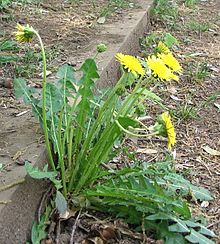 Young leaves, however, are tender and perfect for salads. They taste best before the flowers appear and those grown in complete shade are even better tasting.
Young leaves, however, are tender and perfect for salads. They taste best before the flowers appear and those grown in complete shade are even better tasting.
The roots can be sliced and boiled, like carrots, making an excellent addition to stew. Drinking the water after boiling carrots will also provide you with an excellent source of vitamins. Roots can also be roasted for a richer flavor. Young flower buds can be eaten raw alone or added to salads.
Other Benefits:
The white sap inside of dandelion flower stems is believed to cure warts.
Be sure when collecting your dandelions for consumption that you do not gather them from lawns or other chemically treated areas.
Five: Grass
 While all grasses are edible, the fibrous cellulose can make it difficult to digest or cause intestinal problems if consumed. You can still access the rich nutrients and vitamins by chewing on the grass, swallowing the juices created and spitting out the rest. Another way to get the benefits of grass without the cellulose is to make a tea from grass.
While all grasses are edible, the fibrous cellulose can make it difficult to digest or cause intestinal problems if consumed. You can still access the rich nutrients and vitamins by chewing on the grass, swallowing the juices created and spitting out the rest. Another way to get the benefits of grass without the cellulose is to make a tea from grass.
Grass seeds - except those that are black, purple, or pink in color - can be eaten raw, roasted, or ground into flour.
Other Benefits:
Dry grasses can be used as tinder for a fire
Grass can be used as insulation or bedding
Longer grass strands can be woven to make baskets, mats, or rope
Six: Pine
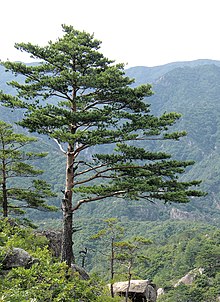 Don’t confuse pine trees with spruce or fir. In the latter, the needles are single, while in the former, they grow in groups of two or more from a common base. Pine trees can be found throughout the world except in the driest desert areas, and offer many survival uses beyond simply a source of nourishment.
Don’t confuse pine trees with spruce or fir. In the latter, the needles are single, while in the former, they grow in groups of two or more from a common base. Pine trees can be found throughout the world except in the driest desert areas, and offer many survival uses beyond simply a source of nourishment.
While not all of the pine is edible, it does have some good sources of wilderness food. Young needles can be chewed and spit out, or swallowed if tender enough. They are rich in vitamins C and A. Older needles can be boiled to make a tea for easier consumption of the nutrients. Some species of pine produce large, delicious seeds, such as pine nuts from the pinion tree.
Other Benefits:
Pine sap can be utilized to help stop bleeding and infection. Pine needles, even live ones, are great fire starters. In wet, rainy places, the lower branches on a pine tree will stay drier than branches on the ground and the dead ones can easily be broken off the tree by hand. Larger branches can be used to build a shelter.
Seven: Juniper
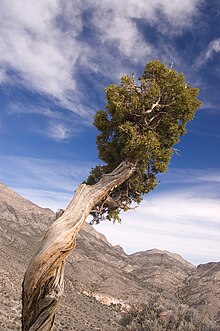 Juniper trees are found in dry, foothills and are short, bushy trees with green or blueberries. The berries can be eaten, particularly when blue. The first year, they are green and turn blue in their second year. They can be sweet or used to flavor stew or meat in the fall of their second year or spring of the third year.
Juniper trees are found in dry, foothills and are short, bushy trees with green or blueberries. The berries can be eaten, particularly when blue. The first year, they are green and turn blue in their second year. They can be sweet or used to flavor stew or meat in the fall of their second year or spring of the third year.
Other Benefits:
As with pine, junipers offer various other uses besides food. The berries have been used historically to prevent infection and the branches make great tinder for fires. If it has been wet or rainy, the outer bark of the juniper tree can be peeled away to expose a fine inner bark which can be pulled from the tree and rubbed between your hands to create a super fine, extremely flammable fire starter.
Eight: Thistle
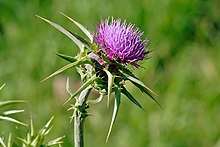 Because of their prickly leaves and stems, thistle does not appear to be edible. However, despite these appearances, it is actually an excellent source of survival food when necessary. The inner stem tastes like celery or raw peas, but getting to it can be tricky. First, cut the plant as close to the base as possible. Then invert the plant and use a knife to peel the outer stem and leaves from the base to the tip of the plant. Consume raw.
Because of their prickly leaves and stems, thistle does not appear to be edible. However, despite these appearances, it is actually an excellent source of survival food when necessary. The inner stem tastes like celery or raw peas, but getting to it can be tricky. First, cut the plant as close to the base as possible. Then invert the plant and use a knife to peel the outer stem and leaves from the base to the tip of the plant. Consume raw.
The roots can be bland when eaten raw, although, in a pinch, they are edible that way. However, when roasted, some plants develop a sugary flavor that is delicious.
Before the flower blooms, clip the buds and eat either raw or steamed. The flavor is similar to artichoke hearts.
Nine: Willow
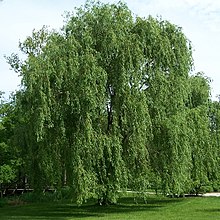 Willows can be full trees or bushy shrubs, but they will always feature their characteristic narrow leaves. Willow trees can usually be found next to or near a water source, which is convenient in a survival situation.
Willows can be full trees or bushy shrubs, but they will always feature their characteristic narrow leaves. Willow trees can usually be found next to or near a water source, which is convenient in a survival situation.
Young shoots and leaves can be eaten raw; however, most people prefer them dried and ground into a fine flour.
Other Benefits:
The inner bark contains salicin, which has effects similar to aspirin. Chew a small amount of the inner bark to reduce pain and inflammation. If the symptoms persist, you can chew a little bit more until the desired effect occurs.
The straight and flexible branches of the river willow are ideal for fishing poles, arrows, and shelters.
Small branches can be woven into baskets or mats.
Before You Eat Any Wild Plant
While you may feel frustrated and desperate in any true survival situation, remember to keep your wits about you. If you cannot clearly identify a plant, then do not attempt to eat it. The body can live three weeks without food, so no need to make yourself sick when you could hold off a little longer.
Avoid any plant that has:
- An almond-like scent in the woody part of the leaves
- Beans, bulbs, or seeds inside pods
- BItter or soapy taste
- Dill, carrot, parsnip, or parsley-shaped leaves
- Grain heads that are pink, purple, or black in color
- Milky or discolored sap
- Spines, fine hairs, or thorns
- A three-leaf growth pattern
While there are no absolutes in nature, these tips could be the difference between life and death. Many poisonous plants are quite similar in looks to perfectly edible ones, so always be sure that you can correctly identify a plant before eating it.
Similar Articles
Indoor gardening has experienced a remarkable transformation in recent years, largely thanks to advances in LED grow light technology.
Most homeowners think sprinkler installation is just about digging trenches and connecting pipes. The reality involves way more steps than people expect.
Learn how regular lawn care enhances curb appeal, boosts property value, and creates a lush, inviting home exterior with simple, effective practices.
Learn why electric lawn mowers are ideal for families—quieter, cleaner, safer, and easier to use, with less maintenance and more convenience for all.
For many families, the backyard is more than just an outdoor space — it’s a central hub for playtime, barbecues, bonding, and making lifelong memories
Imagine sitting in your backyard on a sunny afternoon. The grass tickles your fingers, and the scent of flowers fills the air. Tiny ants scurry around, a honeybee buzzes from bloom to bloom, and a butterfly flutters past.
Discover why hiring professional tree pruning services ensures safety, promotes tree health, and enhances your property’s beauty with expert care and precision.
Discover how a remote mower enhances safety, cuts consistently, and reduces effort on steep hills, offering a smart, efficient solution for challenging lawn care.
Discover why Kikuyu turf is the top choice for lawns: it's durable, low-maintenance, and thrives in sun or shade. Perfect for any landscape, all year round.



